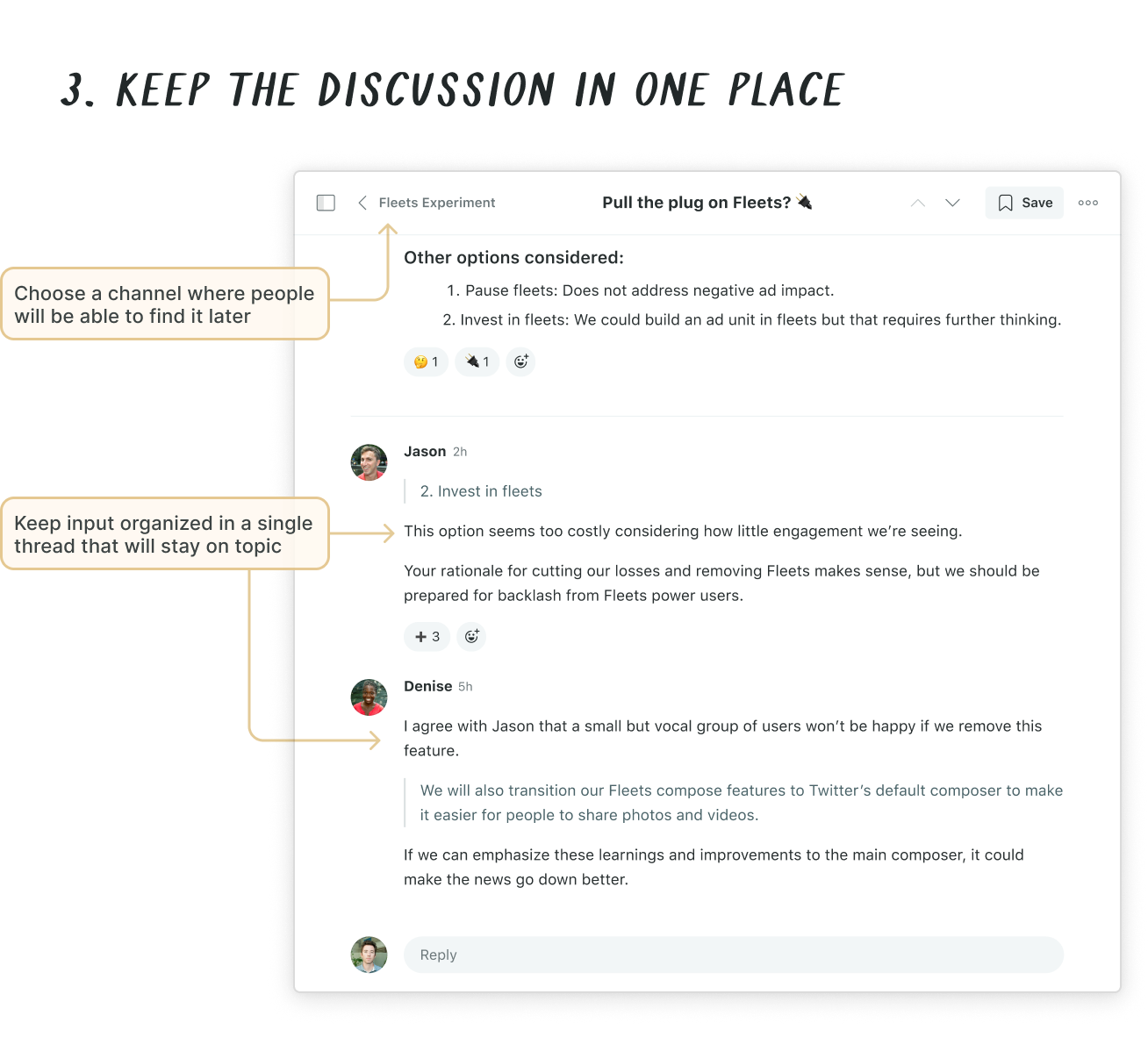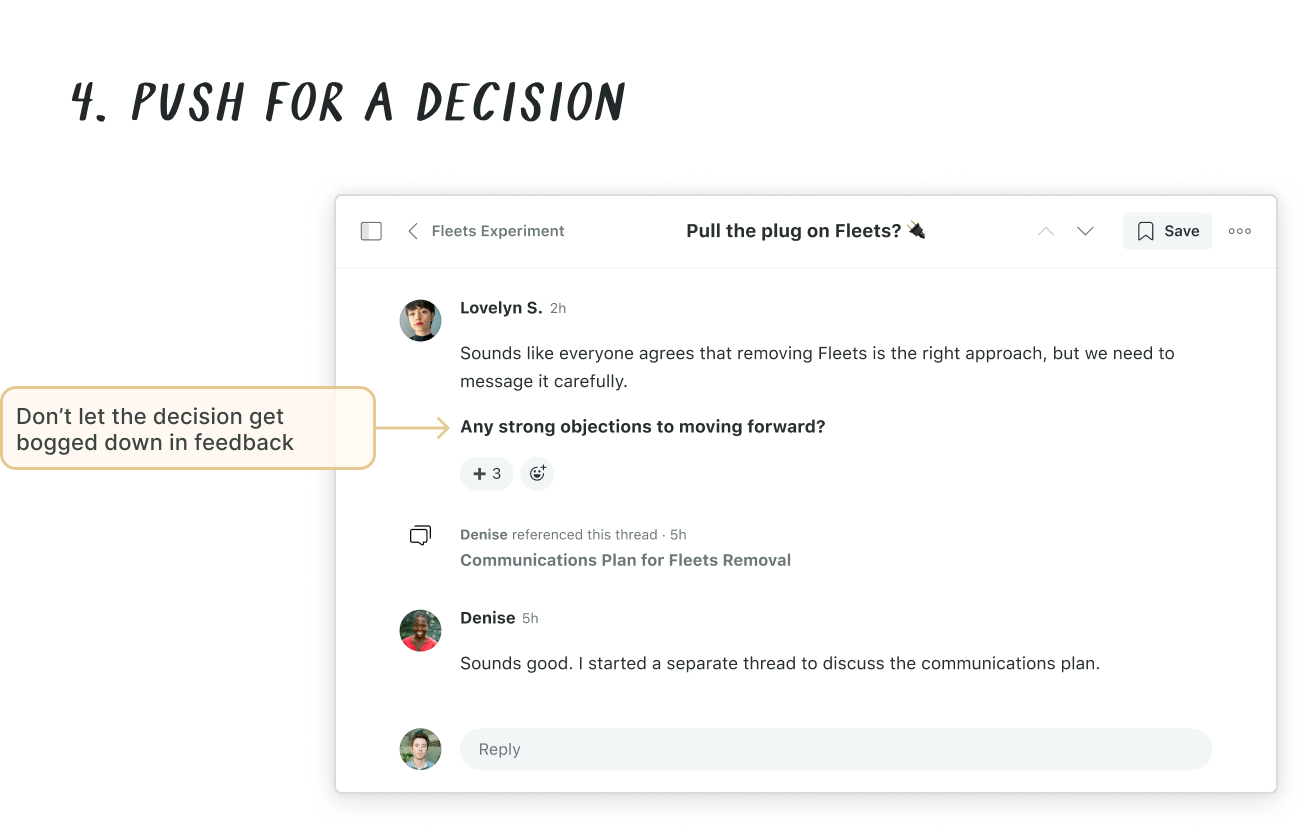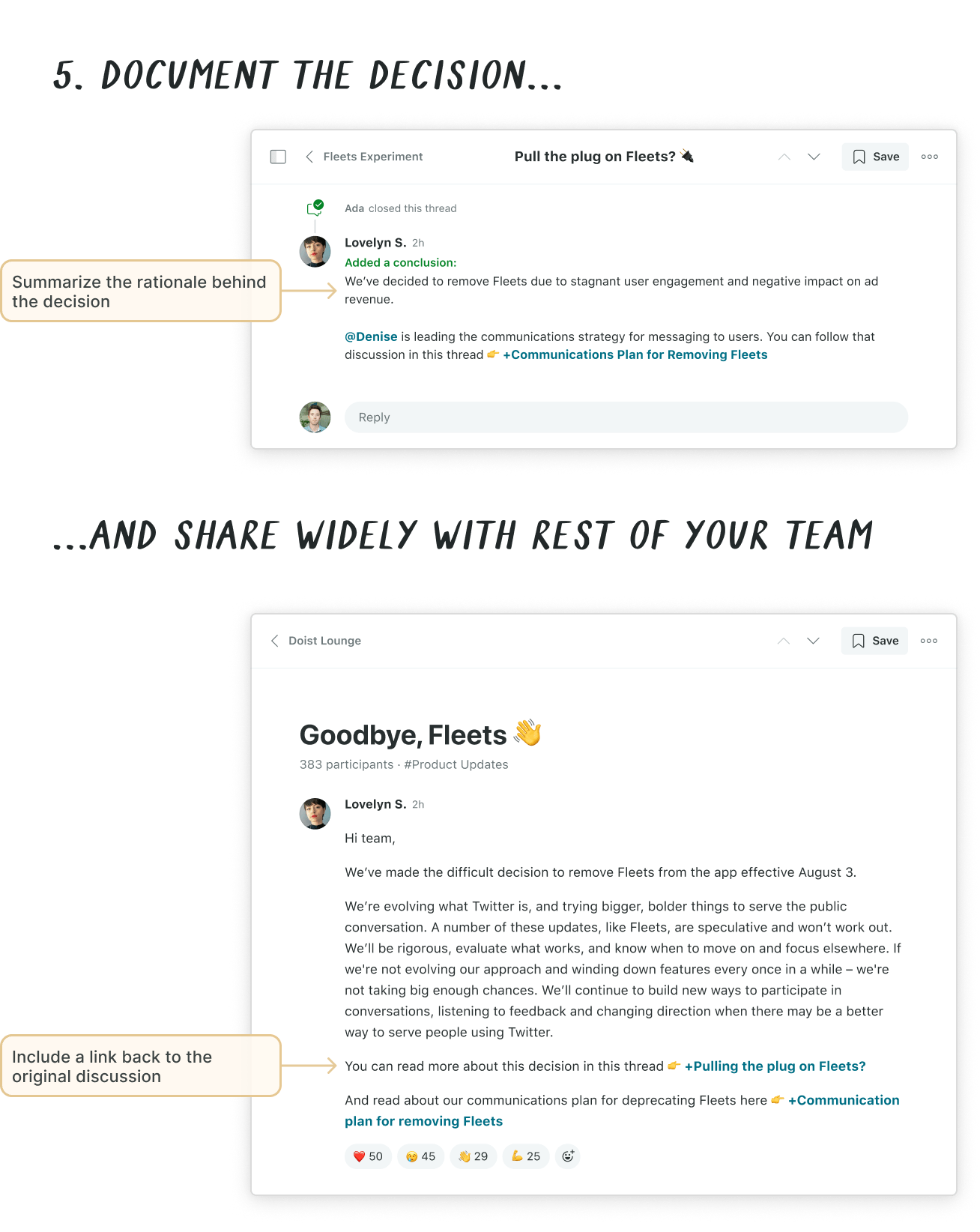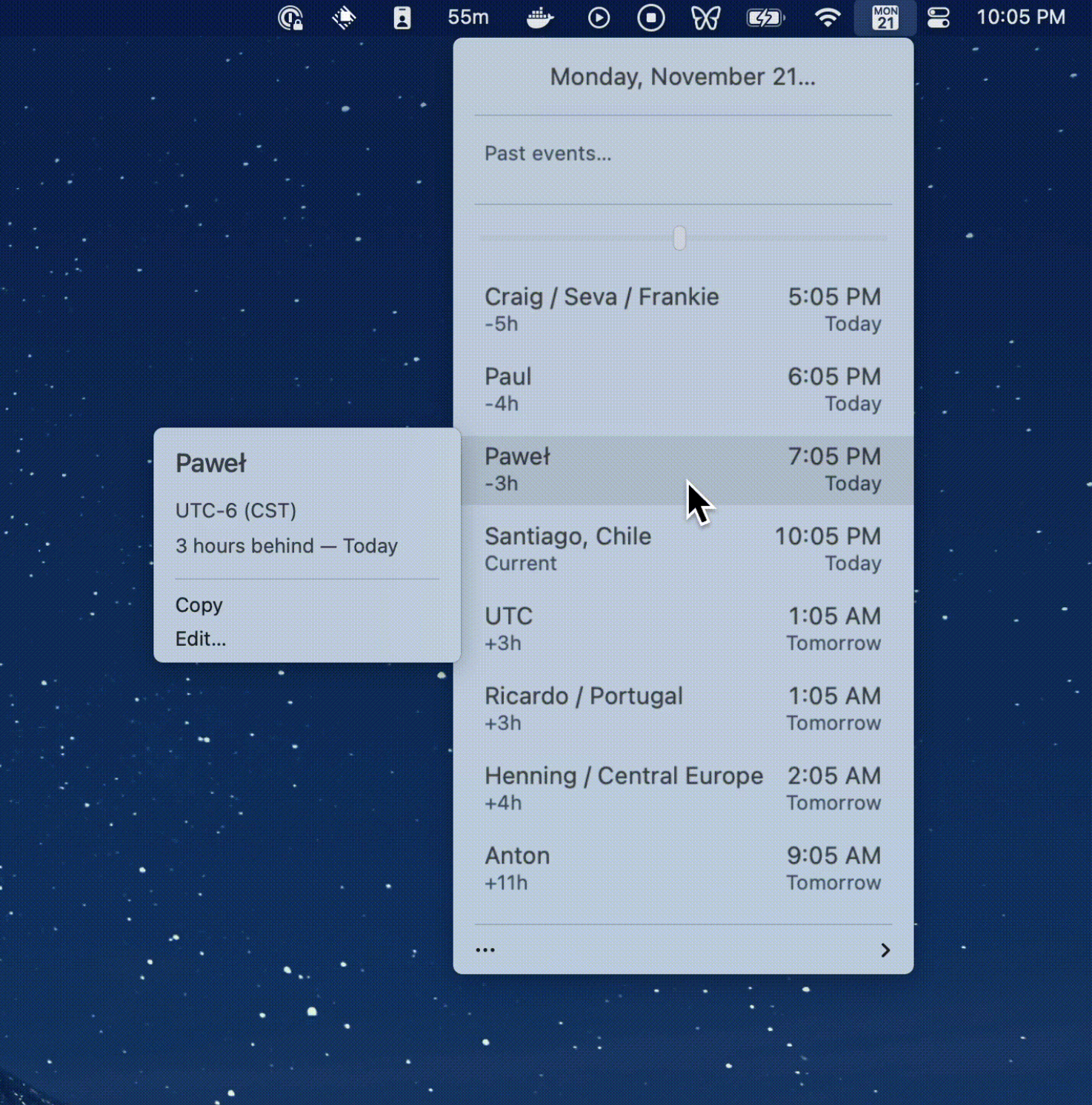How to make great decisions async (and avoid endless meetings)
By Peter Yang

If anyone has to deal with complex decisions that impact multiple stakeholders with real-world consequences for a company's reputation and revenue, it's product managers.
That's why Peter Yang is the perfect async practitioner to be taking over the newsletter this week. Peter has over a decade of experience at companies like Microsoft, Meta, Twitter, Twitch, and Reddit. Over the years, he's found that "the most effective people at these companies are amazing async decision-makers."
In this week's issue, Peter is sharing his 5-step process for making good decisions asynchronously, how to know when you do need a meeting, and 4 tips for running the necessary ones effectively.
I don't think we've ever had a newsletter issue pack so much practical, career-boosting advice into so few words.
Until next time,
Becky and the Twist team

I've worked at Meta, Amazon, and other leading tech companies. The most effective people at these companies are amazing async decision-makers. This is even more true in today’s remote-first world.
So save your colleagues some time and headaches:
Avoid endless meetings by making more decisions async.
I’m going to walk you through how to do this in 3 parts:
- My 5-step process for async decision-making
- Example: Decision doc for Twitter Fleets
- How to run effective meetings (and how to know when you need one)
How to make great decisions async
Based on my experience, 90% of decisions can be made async. If you do this well, you’ll save your team endless hours of meetings (and they’ll love you for it).
Here’s my 5-step process:
Step 1: Identify key people
Every decision should ideally have one decision maker and fewer than five stakeholders to provide input. You don't want to have too many cooks in the kitchen.

Step 2: Set context
The decision maker should start an async thread or decision doc with:
1. List of people involved
2. Context
3. Recommended option (remember don’t bury the lede)
4. List of options considered with pros and cons
Reminder: nobody has time to read long threads or docs, so be as concise as possible.

Step 3: Use one channel for communication
Pick one channel or doc for people to provide input. Avoid starting a bunch of separate threads and then having to play a game of telephone to figure out who said what.

Step 4: Use nested numbered lists to provide feedback
Encourage people to provide input in a list format for easy readability. Use numbered lists vs. bullets to make it easier for people to respond (e.g."I agree with #1"). Here’s an example:
Discussion:
1. Peter: I like option B because of XYZ
a. Daniel: I hadn’t thought of it that way, will add it to the doc.
Step 5: Push for a decision
When it looks like people are reaching alignment, the decision maker should push for consensus:
"It sounds like people prefer #1, any strong objections to moving forward?"
Once confirmed, share the decision far and wide so that everyone is on the same page.


Example: Hypothetical decision doc for Twitter Fleets
As an example of the steps above, here’s a hypothetical decision doc for Twitter Fleets:
People:
1. Decision maker: Ilya (VP)
2. Driver: Becky (PM)
3. Stakeholders: Jim (Consumer lead), Susan (Ads lead)
Deadline: 7/14/2021
Recommendation
Remove Fleets in July.
Rationale
We introduced Fleets on 11/2020 to make it easy for more people to share their lives and join the conversation. However, based on our long-term Fleets holdout, the number of people creating content remains flat at 1% with Fleets. Meanwhile, we’re seeing -5% negative ad revenue due to Fleets pushing the ads down.
Removing fleets will alleviate negative ad impact and give more space at the top of the timeline for other features that are showing more promise (e.g. Twitter Spaces). We will also transition our Fleets compose features to Twitter’s default composer to make it easier for people to share photos and videos.
Other options considered
1. Pause fleets: Does not address negative ad impact.
2. Invest in fleets: We could build an ad unit in Fleets, but that requires further thinking.
Discussion
1. Ilya: The rationale makes sense, let’s do this but make sure we message it right ✅
a. Becky: Thank you. We have a community outreach plan here
The above is a super-simplified example, but you can get a sense of how Twitter actually made this decision in their post announcing the deprecation of Fleets.
How to run great meetings
Of course, some decisions do require a meeting. Usually it’s when:
- A decision has a lot of ambiguity
- A decision is a one way door (hard to reverse once made)
- Your decision doc or thread has a lot of discussion without consensus
Even when you need to do a meeting, having a decision doc is extremely useful.
Here’s how I’ve learned to run productive meetings:
1. Always send out a pre-read and agenda
Create a decision doc and send it out at least one day before the meeting to the key stakeholders. Encourage everyone to read it and leave feedback in the doc before the meeting.
2. Decision meetings should be a discussion
If people haven’t read the document, spend the first 5 minutes of the meeting forcing everyone to read it themselves. Meetings should be a discussion, not a dog and pony show.
3. Take notes live in a meeting
Screen-share the meeting doc and write down decisions and next steps live so that everyone is aligned. This is an incredible hack that very few people do.
4. Wrap up the meeting and send notes immediately
If there’s 5 minutes or less in the meeting, try to recap it and push for a decision. Then send out the meeting doc with the notes that you captured immediately afterwards.
I hope that you use these best practices to make great decisions async and only use meetings when absolutely necessary. That’s how you make your coworkers feel better:
I schedule alot of Zoom calls and then cancel them to make my coworkers feel better pic.twitter.com/QOdomQFZcV
— Peter Yang (@petergyang) September 10, 2022
If you have any questions, I can be reached on Twitter.
3 things worth sharing
- This column from The Atlantic on why meetings make us miserable:
When meetings are a waste of time, job satisfaction declines. And when job satisfaction declines, happiness in general falls. Thus, for a huge portion of the population, eliminating meetings—or at least minimizing them—is one of the most straightforward ways to increase well-being.
- This episode of the fabulous podcast You're Wrong About in which Anne Helen Petersen tells the story of "how email took over the world and our working lives, and what it would mean for us to get a little of our lost time back."
- This MacOS app that makes navigating time zone differences a breeze. Here's how one of our frontend engineers, Ernesto García, uses it to know the time for his teammates relative to his own:

What’s Twist? Twist is an async messaging app for teams burned out by real-time chat, meetings, and email.
You don’t need to use Twist to get a ton of value out of this newsletter and community. But if the topics we talk about resonate with you, there’s a good chance the app will too. See what makes Twist different →
🌎 Built asynchronously by the fully remote team at Doist
